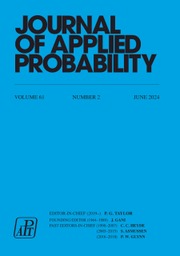Article contents
On queues involving batches
Published online by Cambridge University Press: 14 July 2016
Abstract
It has been demonstrated by Takács in a series of papers and in his book that combinatorial methods can be successfully applied to derive certain probability distributions in queueing processes. In this paper, we further illustrate the usefulness of combinatorial techniques and determine the stochastic law of the busy period in two queueing systems particularly involving batches. It may be of interest to note that queues involving batches have been dealt with in [3] and [7].
- Type
- Short Communications
- Information
- Copyright
- Copyright © Applied Probability Trust 1972
References
[1]
Enns, E. G. (1968) The trivariate distribution of the maximum length, the number of customers served and the duration of the busy period for the M/G/1 queueing system. J. Appl. Prob.
6, 154–161.Google Scholar
[2]
Mohanty, S. G. (1965) Some properties of compositions and their application to the ballot problem. Canad. Math. Bull.
8, 359–372.Google Scholar
[3]
Mohanty, S. G. and Jain, J. L. (1970) On two types of queueing process involving batches. CORS J. 8, 38–43.Google Scholar
[4]
Narayana, T. V. (1955) A combinatorial problem and its application to probability theory I. J. Indian Soc. Agric. Statist.
7, 169–178.Google Scholar
[5]
Steck, G. P. (1969) The Smirnov two-sample tests as rank tests. Ann. Math. Statist.
40, 1449–1466.Google Scholar
[6]
Takács, L. (1967) Combinatorial Methods in the Theory of Stochastic Processes. John Wiley and Sons, New York.Google Scholar
[7]
Takács, L. (1962) A generalization of the ballot problem and its application in the theory of queues. J. Amer. Statist. Assoc.
57, 327–337.Google Scholar
[8]
Takács, L. (1964) Combinatorial methods in the theory of queues. Rev. Inst. Internat. Statist.
32, 207–219.Google Scholar
- 23
- Cited by


